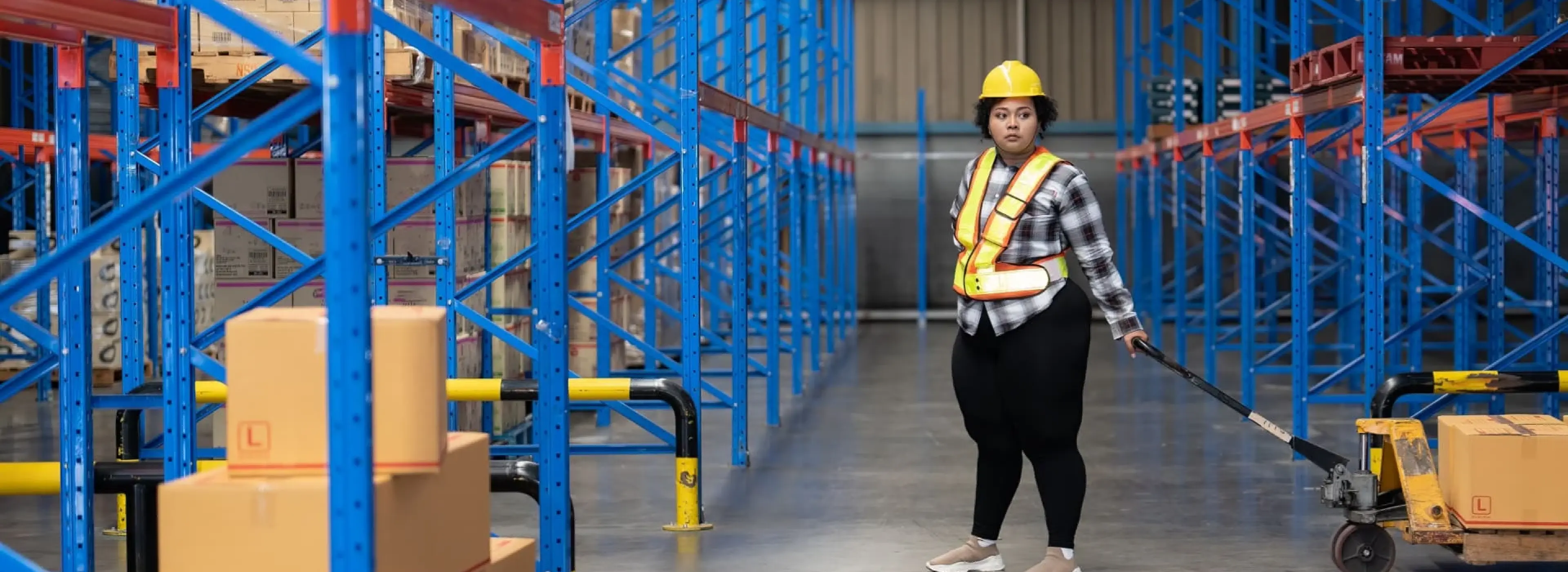For more information about warehouse management or technology trends, follow us on LinkedIn, YouTube, X, or Facebook. If you have other inquiries or suggestions, please contact us here. We’ll be happy to hear from you.
Stockouts or inventory shortages can spell disaster for businesses. Stockouts not only lead to lost sales and dissatisfied customers, but they can also damage a company’s reputation. To help businesses navigate this challenge, we have compiled a comprehensive guide on preventing and managing inventory shortages.
Click Here: Prevent Stockouts With This Advanced and Affordable WMS
In this guide, we will explore the various causes of stockouts and their impact on businesses. From supply chain disruptions to inaccurate demand forecasting, we will delve into the root causes of inventory shortages and provide actionable strategies for prevention.
Additionally, we will discuss effective inventory management techniques that can help businesses minimize the occurrence of stockouts. From implementing the just-in-case (JIC) approach to leveraging data analytics for accurate demand forecasting, we will uncover the best practices for maintaining optimal stock levels.
Furthermore, we will shed light on how to effectively handle stockouts when they do occur. We will offer insights on communication strategies to keep customers informed, alternative sourcing options to minimize downtime, and recovery tactics to mitigate the long-term impact on your business.
Don’t let stockouts derail your success. Read on to discover the tools and strategies you need to prevent and manage inventory shortages effectively.
What is the Meaning of Stockouts?
Stockouts refer to a situation in which a business, warehouse, or retailer runs out of a particular product or item and is temporarily unable to fulfill customer orders or meet customer demand. In other words, it occurs when there is insufficient inventory or stock on hand to meet the current demand or expected sales.

How Inventory Shortages Hurt Your Business
Stockouts can have a detrimental impact on businesses, both in the short and long term. After a stockout, businesses experience lost sales revenue and missed opportunities. Customers who cannot purchase a desired product may turn to competitors, losing market share.
Moreover, stockouts can damage a company’s reputation and customer trust. When customers encounter stockouts, they may perceive the business as unreliable or unprepared. Negative experiences can spread through word-of-mouth and online reviews, further tarnishing the brand’s image.
Furthermore, stockouts can have long-term consequences for businesses. Customers who have experienced stockouts may be hesitant to return to the business, even after stock levels are replenished. This can lead to a loss of customer loyalty and reduced customer lifetime value.
Additionally, stockouts can disrupt the supply chain and impact relationships with suppliers. If a business consistently faces stockouts, suppliers may become reluctant to work with them, leading to higher costs or limited access to critical inventory.
In summary, stockouts have a cascading effect on businesses, resulting in lost revenue, damaged reputation, diminished customer loyalty, and strained supplier relationships. Businesses must prioritize preventing and managing stockouts to maintain a competitive edge in the market.
Why Inventory Shortages Happen
Stockouts can occur due to a variety of factors. Identifying the common causes of stockouts is essential for developing effective prevention strategies. Here are some of the most prevalent causes of inventory shortages:
- Inaccurate Demand Forecasting: When businesses fail to forecast customer demand accurately, they risk running out of stock. Poor demand forecasting can be due to seasonality, changing customer preferences, or inadequate data analysis.
- Supply Chain Disruptions: Disruptions in the supply chain, such as delays in transportation or production bottlenecks, can quickly lead to stockouts. Businesses must have contingency plans to address supply chain risks and minimize their impact on inventory levels.
- Poor Inventory Management: Inefficient inventory management practices, such as inadequate replenishment strategies or lack of visibility into stock levels, can contribute to stockouts. Implementing robust inventory management systems and practices is crucial for maintaining optimal stock levels.
- Sudden Spikes in Demand: Unexpected surges in customer demand can catch businesses off guard and result in stockouts. Businesses should closely monitor market trends and implement agile production and replenishment strategies to respond to sudden increases in demand.
- Product Obsolescence: If businesses fail to anticipate changes in customer preferences or technological advancements, they may have excess stock of obsolete products. This not only ties up valuable resources but also increases the risk of stockouts for more in-demand products.
By understanding these common causes of stockouts, businesses can proactively address them and develop effective prevention strategies. In the next sections, we will explore various strategies for preventing and managing stockouts.
The Importance of Inventory Management in Preventing Stockouts
Effective inventory management is crucial for preventing stockouts and maintaining optimal stock levels. By implementing robust inventory management practices, businesses can minimize the occurrence of stockouts and ensure they have sufficient stock to meet customer demand. Here are some key aspects of inventory management that can help prevent stockouts:
- Safety Stock: Safety stock refers to the extra inventory held to mitigate the risk of stockouts due to unexpected fluctuations in demand or supply chain disruptions. By maintaining a buffer of safety stock, businesses can ensure sufficient inventory to fulfill orders during unforeseen circumstances.
- Real-Time Inventory Tracking: Having real-time visibility into inventory levels is crucial for effective inventory management. By leveraging technology solutions, businesses can track inventory in real time, identify potential stockouts, and take proactive measures to replenish the stock in a timely manner.
- Accurate Demand Forecasting: Accurate demand forecasting prevents stockouts. By analyzing historical sales data, market trends, and customer insights, businesses can forecast demand more accurately and adjust their inventory levels accordingly.
- Supplier Collaboration: Collaborating closely with suppliers can help businesses maintain optimal stock levels. By sharing demand forecasts and collaborating on production and delivery schedules, businesses can ensure a steady supply of inventory and minimize the risk of stockouts.
By prioritizing effective inventory management practices, businesses can significantly reduce the occurrence of stockouts and improve overall operational efficiency. In the next sections, we will delve deeper into specific prevention strategies and techniques.
Strategies for Preventing Stockouts
Preventing stockouts requires a proactive approach and a combination of strategies tailored to the specific needs of a business. Here are some proven strategies for preventing stockouts:
- Implement Just-In-Case (JIC) Inventory Management: The “just in case” involves maintaining a buffer or reserve of inventory beyond what is typically needed to meet current demand. This extra inventory, known as safety stock, is a precautionary measure to mitigate the risk of stockouts and disruptions in the supply chain.
- Leverage Data Analytics: Data analytics can provide valuable insights into customer behavior, market trends, and inventory performance. By analyzing this data, businesses can identify patterns, forecast demand more accurately, and optimize inventory levels to prevent stockouts.
- Diversify Suppliers: Relying on a single supplier increases the risk of stockouts due to supply chain disruptions. By diversifying suppliers and establishing relationships with multiple vendors, businesses can reduce dependency on a single source and mitigate the impact of supply chain disruptions.
- Implement Automated Inventory Management Systems: Manual inventory management processes are prone to errors and can lead to stockouts. By implementing automated inventory management systems, businesses can track inventory levels in real time, set automated reorder points, and receive alerts when stock levels are low.
By implementing these strategies, businesses can significantly reduce the occurrence of stockouts and improve overall operational efficiency. However, even with preventive measures in place, stockouts can still occur. In the later sections, we will explore how to effectively handle stockouts when they do happen.
Effective Forecasting Techniques for Inventory Management
Accurate demand forecasting is essential for preventing stockouts and ensuring optimal inventory levels. By leveraging various forecasting techniques, businesses can gain insights into customer demand patterns and make informed inventory planning decisions. Here are some effective forecasting techniques for inventory management:
- Time-Series Forecasting: Time-series forecasting involves analyzing historical sales data to predict future demand. By identifying trends, seasonality, and other patterns, businesses can forecast demand more accurately and adjust their inventory levels accordingly.
- Statistical Forecasting: Statistical forecasting techniques use mathematical models and algorithms to predict future demand. By analyzing historical data and applying statistical methods, businesses can identify patterns and make more accurate forecasts.
- Predictive Analytics: Predictive analytics combines historical data, statistical models, and machine learning algorithms to forecast future demand. By analyzing large datasets and identifying patterns and correlations, businesses can make more accurate predictions and adjust their inventory levels accordingly.
- Demand Sensing: Demand sensing involves leveraging real-time data, such as point-of-sale data, social media trends, and weather forecasts, to make demand forecasts. By incorporating real-time data into the forecasting process, businesses can respond quickly to changes in demand patterns and adjust their inventory levels accordingly.
- Collaborative Forecasting: Collaborative forecasting involves gathering input from various stakeholders, such as sales teams, marketing teams, and suppliers, to make demand forecasts. By incorporating insights from different perspectives, businesses can make more accurate demand forecasts and adjust their inventory levels accordingly.
By using these forecasting techniques, businesses can gain valuable insights into customer demand patterns and make informed inventory planning decisions.

Implementing Safety Stock to Mitigate Stockouts
Safety stock refers to the extra inventory held to mitigate the risk of stockouts due to unexpected fluctuations in demand or supply chain disruptions. By maintaining a buffer of safety stock, businesses can ensure sufficient inventory to fulfill orders during unforeseen circumstances. Here are some key considerations for implementing safety stock effectively:
- Identify Critical Inventory Items: Not all inventory items require safety stock. Businesses should identify the critical items that have a high impact on customer satisfaction or are prone to supply chain disruptions. These items should have a higher level of safety stock to mitigate the risk of stockouts.
- Assess Demand Variability: Analyze historical sales data and market trends to understand the demand variability for different inventory items. Items with higher demand variability may require a larger buffer of safety stock to account for fluctuations in customer demand.
- Consider Lead Time Variability: Lead time variability refers to the variability in the time it takes for inventory to be replenished once an order is placed. Items with longer lead times or higher lead time variability may require a larger buffer of safety stock to account for potential delays and minimize the risk of stockouts.
- Establish Reorder Points: Reorder points indicate the inventory level at which a new order should be placed. By setting appropriate reorder points, businesses can ensure that they replenish inventory before it reaches critically low levels, minimizing the risk of stockouts.
- Regularly Review and Adjust Safety Stock Levels: Safety stock levels should be regularly reviewed and adjusted based on changes in demand patterns, lead times, and supply chain conditions. By regularly reassessing safety stock levels, businesses can ensure they are adequately prepared to handle fluctuations in demand and supply.
By implementing safety stock effectively, businesses can mitigate the risk of stockouts and ensure they have sufficient inventory to fulfill customer orders. However, even with preventive measures in place, stockouts can still occur. In the next sections, we will explore how to effectively handle stockouts when they do happen.
Dealing with Stockouts: Managing Customer Expectations and Communication
Despite the best preventive measures, stockouts can still occur due to unforeseen circumstances. When faced with a stockout situation, it is essential for businesses to handle it effectively to minimize the impact on customers and their reputation. Here are some strategies for managing stockouts and effectively communicating with customers:
- Promptly Communicate with Affected Customers: As soon as a stockout occurs, businesses should proactively contact affected customers and inform them about the situation. Transparency and open communication are key to managing customer expectations and maintaining trust.
- Offer Alternative Products or Substitutes: If a specific product is out of stock, businesses can offer alternative products or substitutes that meet the customer’s needs. This can help retain the customers and prevent them from turning to competitors.
- Provide Realistic Timelines for Restocking: Communicate realistic timelines for restocking the out-of-stock product. This can help manage customer expectations and give them an idea of when they can expect the product to be available again.
- Offer Discounts or Incentives: To compensate for the inconvenience caused by the stockout, businesses can offer discounts or incentives to affected customers. This can help retain customer loyalty and mitigate the negative impact of the stockout.
- Implement a Waiting List or Pre-Order System: If a product is expected to be restocked soon, businesses can implement a waiting list or pre-order system. This allows customers to secure their place in line and ensures they are notified when the product becomes available again.
- Learn From the Stockout: Use the stockout as an opportunity to learn and improve inventory management processes. Analyze the root causes of the stockout and implement measures to prevent similar incidents in the future.
The Role of Technology in Preventing and Managing Stockouts
Technology is crucial in preventing and managing stockouts by providing businesses with the tools and capabilities needed to optimize their inventory management processes. Here are some key ways in which technology contributes to preventing and managing stockouts:
- Warehouse Management Systems: Warehouse management systems provide real-time visibility into inventory levels, helping businesses track stock levels, reorder points, and lead times. With this information, businesses can proactively replenish inventory before it runs out.
- RFID and Barcode Technology: Radio-frequency identification (RFID) and barcode technology enable businesses to track inventory items at a granular level. This technology allows for accurate and efficient inventory tracking, reducing the likelihood of stockouts due to misplaced or lost items.
- Mobile Apps and Remote Monitoring: Mobile apps and remote monitoring tools enable inventory managers to access inventory data and make decisions on the go. This flexibility helps quickly respond to stockout situations and making adjustments in real-time.
- Inventory Optimization Software: Inventory optimization software uses algorithms and optimization techniques to determine the ideal inventory levels for each product in a company’s inventory. This ensures that businesses maintain sufficient stock while minimizing excess inventory.
Conclusion: The Importance of Proactive Inventory Management to Prevent Stockouts
Preventing inventory shortages requires a proactive and strategic approach. By implementing the strategies discussed in this guide—forecasting accurately, maintaining safety stock, leveraging technology, and continuously analyzing your data—you can significantly reduce the risk of stockouts. Start taking action today to protect your business from the costly consequences of inventory shortages.












